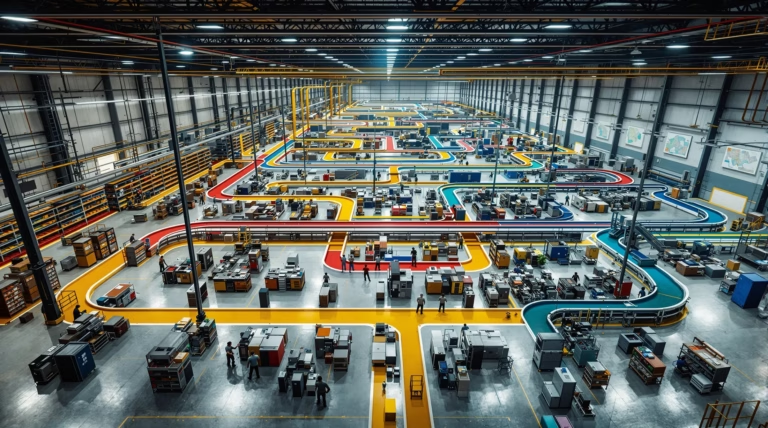Factory Floor Monitoring: Enhance Efficiency and Productivity
Transform your manufacturing operations with advanced factory floor monitoring solutions that provide unprecedented visibility into your production processes. Discover how real-time data collection and analysis can drive operational excellence and boost your bottom line.
Understanding Factory Floor Monitoring
Factory floor monitoring is a transformative technology solution that creates a digitally connected manufacturing environment. These sophisticated systems leverage real-time data collection and analysis to enhance operational efficiency and productivity across the entire facility.
Modern monitoring solutions combine advanced hardware and software components to track machine states and working capacity. The system continuously captures and transmits production data to specialized monitoring software, enabling manufacturers to optimize production flows based on real-time insights rather than historical reports.
What is Factory Floor Monitoring?
Factory floor monitoring encompasses the systematic process of collecting, analyzing, and visualizing operational data from manufacturing equipment in real-time. This technology provides immediate insights into:
- Machine performance metrics
- Production rates and cycle times
- Quality parameters and deviations
- Equipment status and health
- Process efficiency indicators
Key Components of Factory Floor Monitoring
| Component | Function |
|---|---|
| Sensors and Data Collectors | Capture metrics like temperature, vibration, power consumption, and operational status |
| Monitoring Software | Aggregates data and provides dashboards, alerts, and analytics capabilities |
| Network Infrastructure | Ensures reliable data transmission through wired and wireless connections |
| Data Storage Systems | Maintains historical data for analysis and trending |
| Integration Tools | Connects monitoring data with ERP, MES, and maintenance systems |
Benefits of Real-Time Data Collection
Real-time data collection revolutionizes manufacturing operations by enabling immediate visibility into production processes. This instantaneous access to operational information allows teams to identify and address issues within minutes, significantly reducing the financial impact of production problems.
Enhancing Decision-Making with Real-Time Data
Real-time operational data empowers evidence-based decision-making across all organizational levels. The system provides role-specific insights that enable:
- Operators to respond immediately to workstation alerts
- Supervisors to optimize resource allocation
- Managers to identify and address performance trends
- Executives to make informed strategic decisions
- Maintenance teams to prevent equipment failures
Reducing Downtime and Increasing Efficiency
Unplanned downtime can cost thousands of dollars per hour. Real-time monitoring systems combat this challenge through immediate alerts and detailed insights into performance patterns. The technology typically delivers:
- 10-30% productivity improvements without major capital investments
- Instant notifications of machine stops or performance degradation
- Detailed analysis of micro-downtimes and inefficient changeovers
- Pattern recognition for recurring issues
- Data-driven maintenance scheduling
Role of Overall Equipment Effectiveness (OEE) in Monitoring
Overall Equipment Effectiveness (OEE) serves as a fundamental metric in modern manufacturing, providing a comprehensive framework for evaluating production efficiency. This performance indicator integrates three vital manufacturing dimensions – availability, performance, and quality – delivering a clear view of equipment operational effectiveness against its full potential.
When integrated with factory floor monitoring systems, OEE transforms into a dynamic, real-time indicator. Advanced OEE software automatically collects and analyzes production data, calculating effectiveness scores across machines, lines, or entire facilities. This immediate visibility enables manufacturers to identify inefficiencies, implement targeted improvements, and drive proactive decision-making before issues escalate.
Measuring and Improving Equipment Effectiveness
- Availability – percentage of scheduled time equipment is running
- Performance – actual operating speed versus designed capacity
- Quality – percentage of good parts produced
- Automated data collection through machine interfaces
- Real-time calculations reflecting current conditions
Improvement strategies driven by OEE analysis target specific loss categories systematically. For instance, low availability scores might trigger SMED implementation to reduce changeover times, while performance issues could initiate speed optimization studies. This targeted approach typically yields 15-30% productivity gains within existing infrastructure.
Financial Implications of OEE
| OEE Improvement Area | Financial Impact |
|---|---|
| Availability | Reduced labor costs, eliminated wait times |
| Performance | Increased throughput, lower fixed costs per unit |
| Quality | Reduced scrap, rework, and warranty costs |
The financial impact of OEE improvements is substantial. A factory improving from 65% to 75% OEE effectively creates 15% more production capacity without additional capital investment. Even modest gains of 5-10 percentage points can generate returns of hundreds of thousands or millions of dollars annually for medium to large operations, making OEE an invaluable metric for aligning production teams with executive leadership.
Leveraging Data for Predictive Insights
The power of predictive maintenance lies in sophisticated data analytics. Modern systems collect vast amounts of operational data from equipment sensors, creating rich datasets that reveal patterns invisible to human observation. Advanced algorithms analyze these patterns, establishing normal operating parameters and detecting subtle deviations that indicate potential issues. For instance, a predictive system can identify a 5% change in motor vibration signature – imperceptible to operators but potentially signaling bearing wear that could lead to failure.
- Equipment sensor data collection and pattern recognition
- Establishment of normal operating parameters
- Detection of subtle performance deviations
- Real-time monitoring of equipment health
- Machine learning-based prediction refinement
Implementation success requires strategic data management. Manufacturers must identify critical data points, deploy appropriate sensing technologies, and implement robust analytics tools. Leading operations integrate multiple data streams to create comprehensive equipment health profiles:
| Data Stream Type | Monitoring Purpose |
|---|---|
| Vibration Analysis | Mechanical wear detection |
| Thermal Imaging | Heat pattern anomalies |
| Oil Analysis | Lubrication condition assessment |
| Performance Metrics | Operational efficiency tracking |
Cloud-Based Platforms and Their Role in Monitoring
Cloud-based platforms have transformed factory floor monitoring by enabling comprehensive data processing without extensive on-premise infrastructure. These systems collect real-time production data from connected machines, delivering actionable manufacturing insights while requiring lower initial investment than traditional systems.
Through advanced analytics capabilities, these platforms leverage artificial intelligence and machine learning to identify patterns, predict outcomes, and suggest optimizations. Factory managers can access real-time performance metrics remotely, with automated alerts for threshold violations, creating a more responsive manufacturing environment driven by continuous data-based decision making.
Advantages of Cloud-Based Monitoring Solutions
- 40-60% reduction in upfront costs compared to legacy systems
- Simplified implementation and maintenance
- Scalable feature deployment without hardware upgrades
- Simultaneous monitoring of thousands of data points
- Real-time insights through intuitive dashboards
- Standardized monitoring across multiple facilities
Ensuring Data Security and Compliance
Cloud-based monitoring platforms implement comprehensive security measures including end-to-end encryption, role-based access controls, and regular security audits. These solutions often exceed in-house IT security capabilities, maintaining compliance with international standards like ISO 27001 and SOC 2.
| Compliance Feature | Regulatory Benefit |
|---|---|
| Audit Trails | Complete activity tracking |
| Electronic Signatures | Authentication verification |
| Validation Documentation | Regulatory compliance proof |
| Data Sovereignty | Geographic storage compliance |
Continuous Improvement Through Monitoring
Modern factory floor monitoring systems establish the foundation for data-driven continuous improvement in manufacturing operations. Real-time monitoring creates a feedback loop for measuring performance against benchmarks, quickly identifying deviations, and implementing corrective actions before issues escalate.
The strategic value extends to long-term competitive advantage, helping identify capacity constraints, production bottlenecks, and inefficient processes. Manufacturers typically achieve 10-15% productivity improvements within the first year, with sustained gains as the continuous improvement culture matures throughout the organization.
Driving Continuous Improvement with Data
Factory monitoring transforms raw production data into actionable insights that drive operational excellence. The process begins with real-time monitoring systems capturing essential production metrics across the factory floor, including throughput, cycle time, quality, and equipment utilization. This comprehensive data collection creates an objective foundation for performance evaluation and targeted improvements.
- Automated capture of production metrics
- Real-time performance tracking
- Cross-functional team analysis
- Root cause identification
- Data-driven action planning
Through systematic performance reviews, cross-functional teams analyze trends and develop targeted solutions. For instance, when monitoring reveals consistent micro-stoppages in production lines, teams can conduct detailed investigations leading to specific improvements in tooling, maintenance, or training. This structured approach typically yields 20-30% productivity gains while enhancing quality and reducing costs.
Implementing Lean Manufacturing and Six Sigma
Factory monitoring systems provide essential data support for Lean Manufacturing and Six Sigma methodologies. These systems enable teams to identify and eliminate the eight fundamental forms of waste:
- Defects in production
- Overproduction issues
- Waiting time
- Non-utilized talent
- Transportation inefficiencies
- Inventory excess
- Motion waste
- Excess processing
Six Sigma implementations particularly benefit from comprehensive monitoring through the DMAIC methodology. Organizations integrating robust monitoring with Six Sigma projects typically achieve 70% or greater defect reductions while improving throughput and reducing costs. This combination of monitoring technology and proven methodologies creates a sustainable framework for manufacturing excellence.
Energy Management and Sustainability
Modern manufacturing facilities leverage monitoring systems to optimize energy consumption and support environmental initiatives. These comprehensive solutions typically deliver 10-15% energy savings within the first year, simultaneously improving operational efficiency and environmental performance.
| System Component | Monitoring Focus |
|---|---|
| HVAC Systems | Temperature and climate control efficiency |
| Lighting Networks | Illumination optimization |
| Compressed Air | Pressure and usage patterns |
| Production Equipment | Energy consumption during operations |
Optimizing Energy Consumption in Manufacturing
Intelligent monitoring networks enable precise synchronization of energy usage with production demands. These systems automatically adjust environmental controls based on real-time production volumes, typically achieving 15-20% energy savings compared to traditional approaches. The monitoring system’s rapid detection of consumption anomalies enables immediate response to equipment inefficiencies, preventing energy waste and maintaining optimal performance.
- Automated HVAC adjustment based on production levels
- Real-time energy consumption monitoring
- Immediate anomaly detection and alerts
- ROI achievement within 12-18 months
- Significant carbon emission reductions
Sustainable Practices Through Monitoring
Factory monitoring systems enable manufacturers to implement comprehensive sustainability initiatives that go well beyond basic energy management. These advanced platforms provide detailed visibility into resource utilization across production processes, helping identify opportunities for optimization in multiple areas:
- Water consumption reduction through smart monitoring
- Waste minimization and material optimization
- Chemical usage efficiency improvements
- Resource utilization tracking
- Environmental impact measurement
For example, Clean-in-Place (CIP) monitoring systems in food and beverage manufacturing demonstrate remarkable efficiency gains, reducing water consumption by 20-30% while simultaneously decreasing cleaning chemical usage. These improvements create both environmental benefits and significant cost savings.
| Asset Management Area | Monitoring Benefits |
|---|---|
| Equipment Lifecycle | Extended lifespan through optimized maintenance |
| Capacity Utilization | Identification of underutilized equipment |
| Performance Analysis | Data-driven repair vs. replacement decisions |
| Operational Context | Balance between productivity and energy usage |
Platforms like MachineMetrics provide comprehensive insights into equipment operations, enabling manufacturers to create a virtuous cycle where environmental responsibility and operational excellence reinforce each other. This integrated approach to sustainability through monitoring delivers lasting competitive advantages in resource-constrained markets while maintaining optimal production efficiency.







